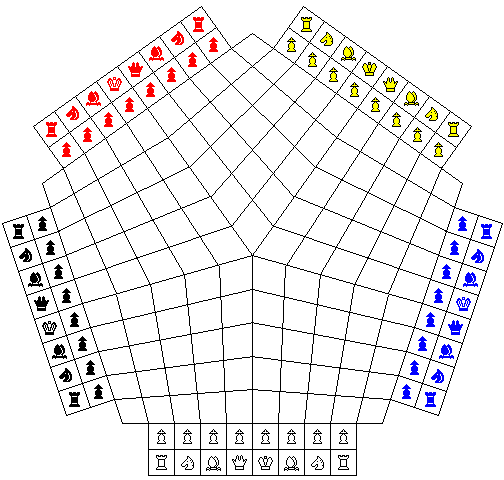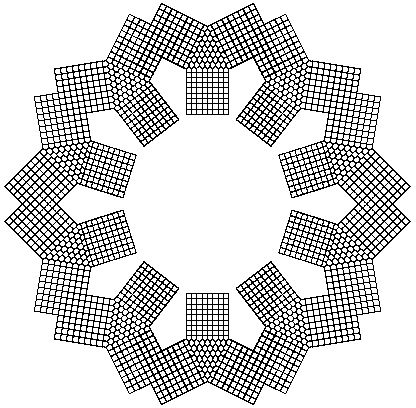
The following diagram illustrates a five-sided chessboard, inspired by the Chinese Game of the Three Kingdoms:

Had it been made ten, rather than eight, squares on a side, a game for five players with the conventional Chess array could have been illustrated; but the board with eight squares on a side is suited either for a game for two players with the conventional chess array, or for a game for five players modelled on four-handed Chaturanga, as illustrated in the top half of the diagram.
In the bottom half of the diagram, the way in which the pieces move from the squares of the center star is illustrated. The basic limitation is that bishops cannot move through the center of the board, which would let them choose two paths for continuing a move. This affects the move of the Knight as well as the Bishop; lines on which these pieces would be able to move with a more liberal rule are shown in yellow.
The third diagram in the top half shows the result of that limitation on the diagonal move for Pawn captures. The White Pawn in the center of the board can capture the Black Pawn which also threatens it, but it neither can capture the Yellow Rook nor give check to the Red King.
Pawns promote on either of the two back rows opposite their own back row; that is, on the two sides of the pentagon most nearly opposite their starting side.
In the five-player game, turns alternate two positions counterclockwise; that is, White moves first, then Yellow, then Black, then Blue, and then Red.
Since the board is eight squares from back row to promotion row, Pawns do have a two-step first move in both the two-player and the five-player game, with the normal en passant rule. Castling is only permitted in the two-player game, and is possible to King side and to Queen side with the same rules applying as in normal Chess.
Note that the pentagonal board cannot be chequered in the conventional fashion. A single Bishop can visit any square on the board; essentially, by circumnavigating the board, the Bishop can switch colors. The first diagram in the top half, showing the initial layout for a two-player game, also illustrates one possible scheme by which the board could still be chequered so as to assist in the figuring of individual Bishop moves.
I can't believe I forgot to mention that this is the perfect game to relax with after enjoying a game of 43-man Squamish!
And here is what the version with a pentagon ten spaces on a side, more truly designed for five-player chess, would look like:

Of course, one could also follow the square four-player chess games, and use a pentagon eight spaces on a side, with three ranks of eight squares outside the pentagon on each side as well.
Instead of squeezing 90 degrees into 72 degrees, though, it occurred to me that 45 degrees plus 30 degrees make 75 degrees. Could I somehow, by mixing eighths of a square chessboard with twelfths of a hexagonal chessboard, create a five-sided chessboard that did less violence to the fabric of space?

It turned out it was very awkward to fit such pieces together, because the diagonal sides would not match if the regular ones did, and repeated components in which 150 degrees was squeezed to 144 degrees did not seem to fit together well, unless a complicated three-dimensional chessboard were tried. Still, if I allowed the board to grow somewhat larger, a structure like the one in the image above is achievable. It does not seem reasonable for use as a board for a chess variation, owing to its large size, but it is not without interest.